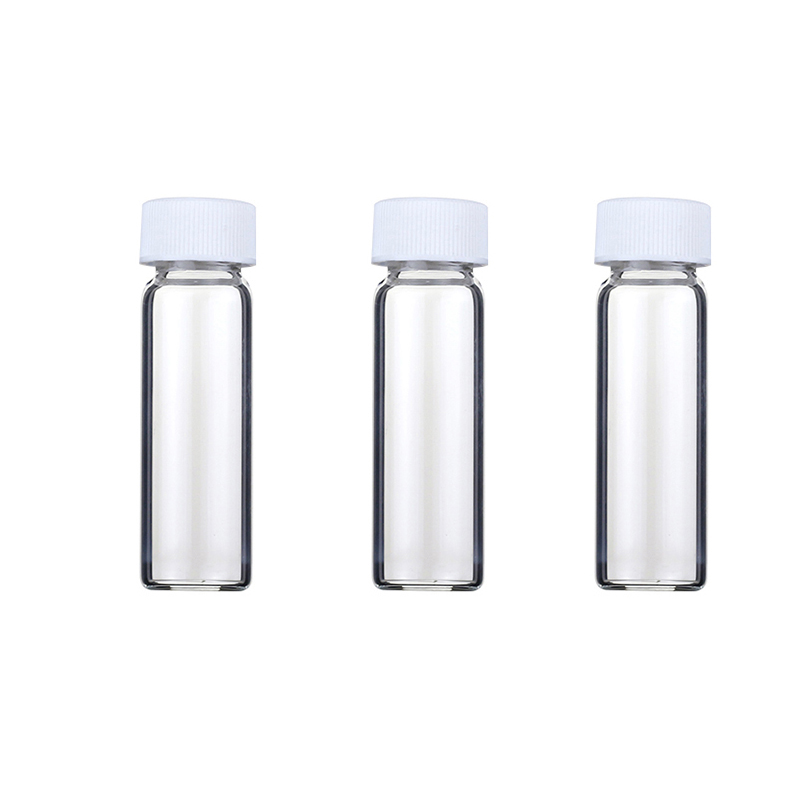Explanation of the Leak-proof Design of Scintillation Vials
🫙 Introduction
In the laboratory, scintillation vials are widely used for radioisotope experiments, liquid scintillation counting and other high-precision chemical analyses. Not only do they need to be chemically resistant, they must also ensure safe storage and accurate measurement of samples.
Leak-proof design is crucial during experiments. Inadequate sealing of the vials may lead to sample volatilization, cross-contamination, and knitting jeopardizing the safety of the experimenters. In addition, leakage may affect the accuracy of experimental data, which in turn affects the reliability of research conclusions. Therefore, high-quality leak-proof design plays an important role in ensuring experimental safety and data accuracy.
In this paper, we will analyze in detail the basic structure of scintillation vials, the core principles of leak-proof technology and its application value in experiments, and provide guidelines for choosing appropriate products to help researchers optimize the experimental process and enhance laboratory safety and the credibility of experimental results.
🫙 Basic Construction of Scintillation Vials
The design of scintillation vials directly affects their sealing performance, chemical resistance, and the accuracy of experimental data. The following are key aspects of their basic construction:
1. Material analysis: glass vs. plastic (polyethylene, polypropylene)
-
- Glass bottles: usually made of borosilicate glass with excellent chemical resistance, suitable for experiments requiring high solvent stability.
- Plastic bottles: mainly made of polyethylene or polypropylene, lightweight and unbreakable, suitable for some low-risk experiments. However, compared to glass, some plastics may interact with certain solvents and affect the results.
2. Cap design and sealing mechanism
-
- Screw cap: Precision threaded structure to improve sealing and prevent leakage of volatile samples.
- Sealing gasket: common materials include PTFE, silicone, etc., to enhance airtightness and reduce solvent evaporation.
- Snap-on lid: Suitable for quick access to samples, slightly less airtight than screw-on lids, generally used for non-volatile liquids or short-term storage.
3. Variety of volumes and sizes
-
- Small capacity (5-10ml): suitable for trace samples or short-term experimental storage.
- Medium capacity (15-20ml): the most common size, suitable for liquid scintillation counting and general radioactivity measurements.
- Large volume (30ml and above): suitable for experiments requiring higher sample volumes, such as prolonged monitoring or analysis of highly concentrated samples.
Different experimental needs determine the appropriate choice of scintillation vials. A proper understanding of the apparatus doggie helps to optimize the experimental process and ensure experimental safety and data accuracy.
🫙 Core Technology for Leak-Proof Design
The leak-proof performance of scintillation vials directly affects the safety of the experiment and the reliability of the data. The efficient sealing design prevents volatile liquid leakage, avoids sample contamination and ensures solvent stability. The following are the core technologies of leak-proof design:
1. Gasket or Liner
The sealing gasket is located inside the cap and fits tightly into the bottle opening to enhance air tightness and prevent solvent evaporation or leakage. Common materials include:
-
- Polytetrafluoroethylene (PTFE): Extremely chemically resistant, suitable for highly corrosive, organic solvents or radioactive samples, ensuring stability over long periods of storage.
- Silicone: Soft and resilient, providing excellent leakage protection for experiments that require a good seal but do not involve highly corrosive solvents.
The choice of sealing gasket depends on the characteristics of the solvent, ensuring the best sealing effect while avoiding material compatibility issues.
2. Screw cap design
The screw cap adopts precise thread design, forming a tight connection with the bottle mouth to avoid liquid leakage. Its sealing principle includes:
-
- Multi-threaded design: Provides a larger contact area, increasing seal strength and reducing the risk of air ingress or liquid leakage.
- Lined sealing layer: with PTFE or silicone sealing gaskets to further enhance airtightness, suitable for highly volatile or toxic solvents.
The sealing performance of the screw cap is particularly important during long term storage and transportation to minimize the impact of environmental factors on the samples.
3. Pressure balance and airtightness optimization
Different experimental conditions (e.g. temperature changes, air pressure fluctuations) may lead to differences in internal and external pressures, affecting sealing performance. Therefore, the scintillation vials were designed using the following optimization:
-
- Negative and Positive Pressure Sealing Test: Ensure that the sealing status can be maintained under collateral or high pressure environment to prevent sample leakage.
- Seal structure adapted to different experimental needs: optimized cap design for highly volatile solvents, extreme temperatures or long-term storage to ensure experimental stability.
Through the application of the above core anti-leakage technologies, scintillation vials can effectively prevent leakage, safeguard laboratory safety, and ensure the accuracy and reliability of data.
🫙 The Value of Leak-Proof Design in Experiments
Leak-proof design not only affects the reliability of experimental results, but is also directly related to laboratory safety. High-quality scintillation vials play an important role in several experimental scenarios through effective sealing mechanisms.
1. Ensuring the accuracy of experimental data
-
- Avoid sample volatilization or contamination: Many experiments involve highly volatile or sensitive samples such as radioactive solutions or organic solvents. If scintillation vials are not sealed properly, the sample may partially evaporate, resulting in biased experimental data.
- Prevent cross-contamination from affecting results: A good seal can effectively prevent external contamination from entering the bottle and avoid cross-contamination between samples, ensuring the reproducibility and accuracy of experimental data.
2. Enhance laboratory safety
-
- Prevent toxic and hazardous solvents from leaking: many experiments use chemical bottles with toxicity, corrosivity or radioactivity. If leaked, it will not only pollute the experimental environment, but also may pose a threat to the health of experimental personnel.
- Protect laboratory personnel and the environment: the efficient sealing design can reduce the release of harmful gases and reduce laboratory air pollution, while reducing the risk of laboratory personnel coming into contact with dangerous chemicals, in line with laboratory safety management standards.
3. Applicable to various experimental scenarios
-
- Radioisotope experiments: Radioactive liquids have potential biological and environmental hazards, good leak-proof design can ensure the safety of samples during testing and storage.
- High sensitivity chemical analysis: such as liquid scintillation counting and other precision experiments, the sample is required to maintain chemical stability before measurement, to prevent volume loss or contamination to affect the measurement results.
- Long-term storage and transportation: Some samples need to be held for long periods of time or transported across regions, and a high-quality leak-proof design prevents leaks caused by temperature and pressure changes, ensuring that samples remain stable throughout the experimental cycle.
In summary, the leak-proof design of scintillation vials not only improves the reliability of experiments, but also provides safer protection for lab personnel and the environment, making them one of the indispensable containers in the laboratory.
🫙 Choosing the Right Scintillation Vials
Choosing the right scintillation vials is critical to the safety of the experiment and the accuracy of the data. Here are a few key factors to help researchers make the best decision.
1. Selecting the right material according to the experimental needs
Glass Scintillation Vials
-
- Suitable for highly corrosive organic solvents, such as methanol and toluene.
- High chemical stability, not easy to react with samples, suitable for precision experiments.
- Suitable for long time storage, but heavy and fragile.
Plastic scintillation vials (polyethylene/polypropylene)
-
- Lightweight and unbreakable, suitable for bulk sample handling or field experiments.
- Suitable for water-based samples or non-polar solvents, but may interact with some organic solvents.
- Suitable for short-term storage and high-throughput experiments.
2. Comparison of leakage prevention performance of different brands
-
- Cap and sealing gasket design: different brands of scintillation vials use different sealing technologies, such as PTFE gaskets, silicone gaskets, etc. Users should choose a sealing structure suitable for the experimental solvent.
- Screw cap vs. Snap cap: Screw caps usually have a stronger seal and are suitable for volatile solvents, while snap caps are suitable for short time storage or non-volatile samples.
- Experimental validation: You can refer to the user evaluation, laboratory test data or official sealing test to choose the most suitable brand and model.
3. Suggestions for purchase and use
Suggestions for purchase
-
- Choose certified brands to ensure quality and safety.
- Select the appropriate sealing material according to the type of solvent to avoid solvent leakage or chemical reaction.
- Pay attention to batch consistency when purchasing to ensure the stability of experimental data.
Precautions for use
-
- Ensure the cap is tightened to avoid bad sealing leading to sample volatilization.
- Avoid exceeding the maximum capacity of scintillation vials to prevent leakage due to liquid expansion.
- Perform a sealing test before transportation or prolonged storage to ensure experimental safety.
Proper selection and use of scintillation vials can effectively improve experimental precision, ensure experimental safety, and reduce the risk of sample loss.
🫙 Conclusion
The leak-proof design of scintillation vials plays a vital role in the laboratory environment. A quality seal not only prevents sample volatilization and cross-contamination, but also ensures the accuracy of experimental data and enhances the reliability of research. In addition, good leak-proof technology can also effectively reduce the risk of toxic or corrosive chemical leakage, protect the safety of experimental personnel and avoid environmental pollution.
With the continuous upgrade of experimental needs, the leak-proof design of scintillation vials is also being optimized. Possible future trends include more efficient sealing materials, intelligent and automation-compatible design, environmentally friendly materials and recyclable design.
Although high quality scintillation vials have good anti-leakage performance, the correct way of using them should not be neglected. Experimenters should choose the right material and sealing method according to their experimental needs, and make sure the cap is tightened and sealed properly during operation. Meanwhile, sealing test should be conducted before long time storage or transportation to further reduce the risk of leakage.
In conclusion, the leak-proof design of Scintillation Vials plays a key role in laboratory safety and data reliability. Through scientific and rational selection and use, it can effectively guarantee the smooth running of experiments and improve the accuracy and reproducibility of research results.

 Italiano
Italiano Português
Português
